I didn’t know I was going to Tintagel or I’d have 1) booked tickets to the castle 2) read my guidebook about the village 3) taken the Once and Future King with me. But I thought I was having a weekend walking on Dartmoor so I didn’t do any of that!
It was my birthday weekend. I’d already spent my birthday not walking on Dartmoor, which was the plan I’d made right from the start. Actually, the plan was – tentatively – to go to Exeter Cathedral and then find an open air pool but I’d swum the night before and my stuff was still on the line when I departed and there was standstill traffic for miles in all directions around Exeter so those plans got abandoned. Still, I wasn’t walking on Dartmoor on my birthday. The trouble was that the next day, when I was definitely supposed to head out to the moor, I didn’t want to. I’d had to rush out on Friday for emergency extra rope to hold down my brand new four-man tent in a strong breeze and in the process, discovered the Cornish border was less than ten minutes away, even taking into account those ten minutes including a lot of slow, narrow, winding country lanes. “Don’t want to hike” plus “Cornwall’s just over there” led to a visit to Google Maps and that led to me “Tintagel’s only three-quarters of an hour away”.
My first impression is that this is an odd village that doesn’t quite know what it wants to be. It wants to be a quaint grey stone Cornish village because that’s what it is. It wants to be a seaside resort because it’s got some nice coast and it’s packed with tourists. And of course, it wants to be the site of myth and legend and magic because that’s what the myths and legends say. I parked at the east end of the busy part of the village, by the visitor centre. It was the first car park I saw and it had plenty of space and I wasn’t going to mess around. As I walked east towards the sea and the castle, more and more beach shops and cafes and pasty places appeared and more and more mythical names. I was opposite the Sword in the Stone car park. I passed King Arthur’s Great Halls and the Celtic Legend gift shop and King Arthur’s Arms Inn and so many shops with swords and fake-medieval goblets in the window.
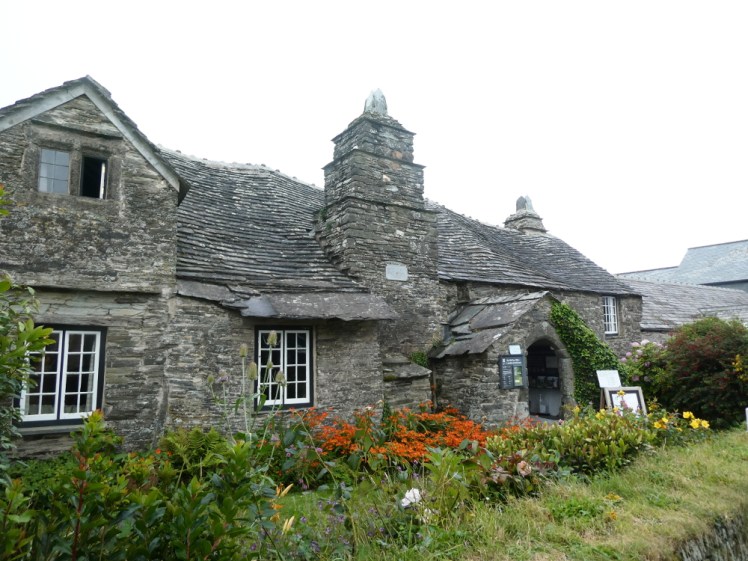

One thing you may not know about me is that I love the Arthurian tales. Well, specifically I love TH White’s The Once and Future King, which is the name for the collection of five books he wrote, one of which being The Sword in the Stone. I bought it with the proceeds of a prize I won at school (I can only think of my year 13 default Spanish prize but I’m sure I bought it earlier than that, although I don’t remember winning any other prize in secondary school) and I’ve read it half to death. I skip The Book of Merlyn because that’s mostly just the Sword in the Stone again, only written by a badger for his thesis, or something like that. My favourites are The Witch in the Wood, which mostly deals with the Orkney boys, and the Ill-Made Knight, which is Lancelot’s story. The Witch in the Wood is the one relevant here.
I vividly remembered that the Orkney boys’ grandparents had two castle, Tintagel and Terrabil. Because I’d never encountered Tintagel when I first read it and I knew the word “terrible”, I pronounced the two “TIN-t’gel” and “Terr-ible” and by now I know that’s incorrect but it’s still how I remember the two names. If I’d known I was coming to Tintagel, I’d have taken the book with me and then I wouldn’t have had to sit on a bench on the cliff, staring over at the castle with my notebook open and trying to put together the trees.

The way it went was that “the chaste and beautiful Countess of Cornwall” (“Granny”, or Igraine) was the mother of the three lovely Cornwall sisters, Elaine, Morgan le Fay and Morgause. Igraine caught the eye of Uther Pendragon and when she declined his advances, being already married, he declared war on the Cornwalls. Igraine hid in Tintagel and the Earl of Cornwall, who is unnamed in this book, fights Uther at Terrabil. And loses. Off goes Uther to Tintagel, besieges the castle and takes Igraine prisoner. The result is their son, King Arthur. The Orkney boys hate him for the sins of his father and even more when he accidentally produces Mordred with his half-sister, the Orkney boys’ mother Morgause. That’s what I sat and tried to draw out from memory (going a little further, including Guinevere, Lancelet, the other Elaine and Galahad, not to mention the names of the Orkney boys).
It’s just two pages in a book 810 pages long, a story from the past whispered between four young boys to remind themselves why their enemy is their enemy. I’ve since invested in the leatherbound volume of the original 14th century book by Malory, which is written in much less accessible language but nonetheless regularly quoted in The Once and Future King – I recognised the phrase “and there the King pight many pavilions and there was great war made on both parties and much people slain”. In Malory, this isn’t just a story told later, this is the origin of the entire book but it’s still less than four pages (this time out of 749, although the book itself is physically larger). I suppose it’s the groundwork for the entire myth. No Igraine, no Tintagel, no Arthur, no stories. I also suppose it’s the only place in the entire legend that has a solid indisputable location.
Anyway, that’s a lot of background to explain that I am familiar with the stories and what Tintagel’s real significance is.

It was quite early on a grey Sunday morning when I arrived. I’d been in a bit of a hurry to get out of my tent and hadn’t thought about bringing any food with me so I walked through the village with half an eye on the pubs and cafes. I’m still not ready to go inside unmasked so I wanted somewhere with outside seating, or takeaway, which might perhaps do something that featured melted cheese. It’s well set up for a tourist village – endless cafes, pubs, food places, two small supermarkets, menus in windows, the smell of pasties even at that hour. I found the castle easily enough – well, I found the sign saying “Online tickets only – tickets sold out”. I’d only decided about 10pm the night before that I was coming here. It didn’t really occur to me that there was a castle and it definitely didn’t occur to me that it might have tickets or that I might need to book in advance. It’s Monday 16th right now and it’s sold out until Wednesday so undoubtedly even I had thought to try to book tickets that night, it would probably have been sold out anyway. It’s £17.30 for an adult, or free to English Heritage members but you still have to pre-book your free ticket.
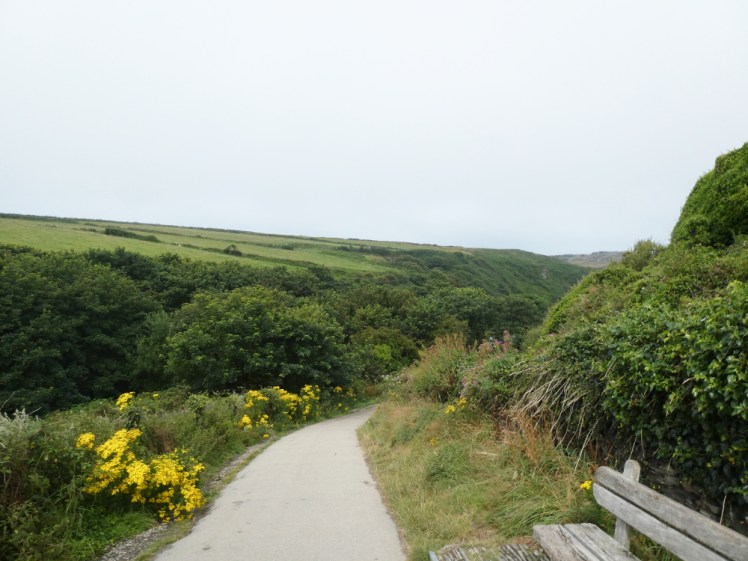

I didn’t mind that I couldn’t go in. I walked down the long valley and found that the views from the bottom and from the cliffs opposite were more than good enough for me. In fact, there’s no castle anymore, just ruins. Still, I could imagine Uther and his pavilions and his army advancing on this place, I could imagine Igraine hiding and her men fighting, I could imagine baby King Arthur getting his first look at the world from here. This is where it happened. This is where it began. Ok, I see the hype.
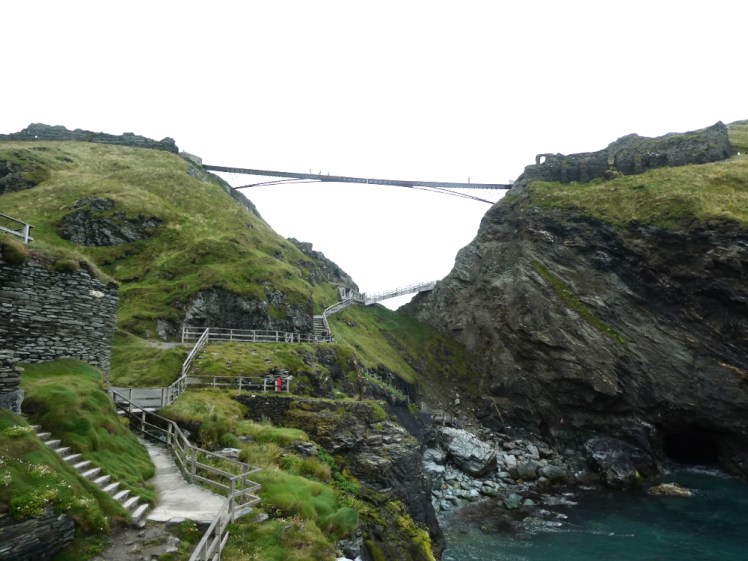
But first and foremost I’m a rock person and Tintagel’s castle island is a spectacular chunk of rock. Granite, I assume. My own areas of expertise are limestone and lava so I have no idea what’s happening here but I liked it. I also liked the way it plummeted down to a startlingly blue-green sea. This is due to copper in the rock, apparently but it makes a stormy rainy bit of southern England look positively tropical. And it’s so clear! Probably cold, though. There’s a crystal-clear stream that runs down the valley and tumbles into the sea right at the bottom and near the top was the perfect place to paddle. Wearing my sandals, I’d been unable to resist and although it was indeed lovely and clear, it was freezing. And it made all the dirt and gravel stick to my feet all the way down the path and made my feet slip in the sandals. For future reference, I’ll be pausing to paddle on the way up in future.


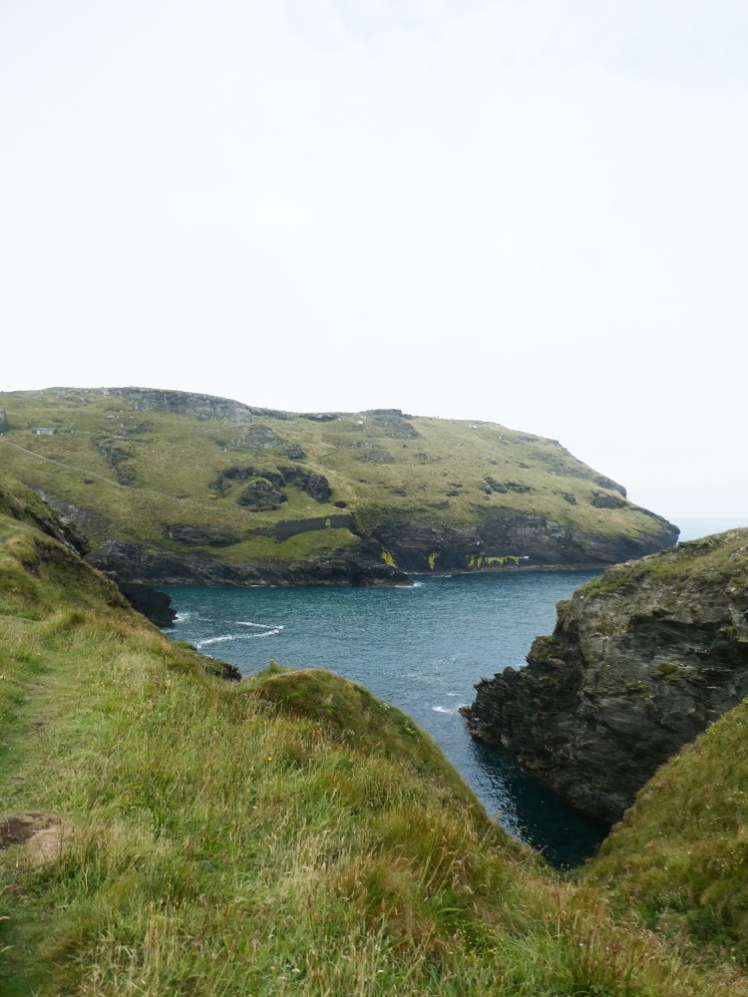
I followed the South West Coast Path just a little way, just to the chunk of rock opposite. More good views over the castle but overshadowed, for me, by the spectacular views north-east along the coast. Cliffs, headlands, stacks, stumps, all features I’m familiar with from the Dorset end of the SWCP but somehow they look completely different in granite to chalk. There was a mist in the distance casting mood and atmosphere over it too and the whole… I just stood there and said out loud “Wow…!”. The headland closest was tilted over so steeply that its strata were vertical and if it wasn’t for the castle and the myth, surely this area would have as much place in geography textbooks as the Jurassic Coast does. One day I’m going to walk this section of the path – maybe later this summer, maybe in the autumn. Don’t worry, I’m familiar with coasts and cliffs and weather, I’m not going to do it when it’s dangerous but I’d like to get to know this bit of coast better and it is one of my plans to eventually walk the entire SWCP, although I’ll be doing it in day-walks over many years rather than in one go.

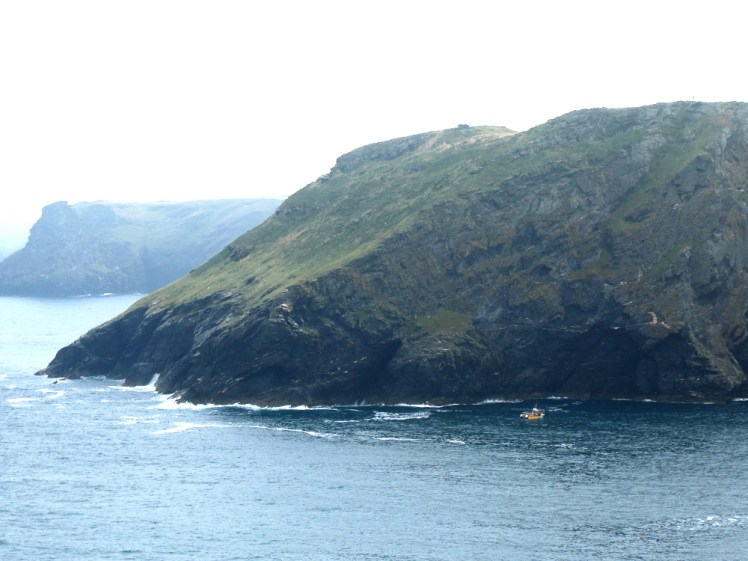
If you like cliffs or rocks or coastal scenery, forget the castle and just walk down here. I hadn’t been disappointed to miss the castle anyway but now I forgot it existed. They clatter on about the legends and they never mention the geology? Look at the geology!

However, the geology is mean. To get back to the village and back to my car, I had to walk back up the steep valley. I believe there’s another way that involves heading straight back inland from the cliffs, via the big ugly crenelated hotel but I didn’t know anything about it and rather than get lost on the cliffs, I walked back up the normal way. I’m so bad at hills. I stopped so many times and I wasn’t just sweaty when I got back to the top; I was actually soaked as if I’d jumped in the sea. I was also hungry and thirsty. Now to make use of whatever I’d spotted as I walked through. The trouble was that anywhere with outdoor seating seemed full and suddenly it was all pasties. Eventually I reached the first place I’d looked at, which was the last place before my car park.

Primrose Cottage Cafe Tea and Coffee Shop. They had outdoor seating. There was a table for two vacant and the presumed-owner waved me to it, took my order from me standing by the door sweating and lost and confused and desperate for cheese and probably low on blood sugar. A glass of wonderful cold Coca Cola appeared and I’d cooled down enough to eat by the time a wonderful fluffy over-filled cheese sandwich and pile of salad appeared. Nothing I couldn’t have made myself on the campsite (although 48 hours into the trip, my cheese was probably past its best) but so much tastier made by someone else and served on a pretty china plate at a nice tiled mosaic chair in a Cornish seaside village. I don’t eat out often so when I do it’s a novelty and this was a particularly well-appreciated novelty. Probably I should have had scones but I don’t like cream and I don’t like tea.
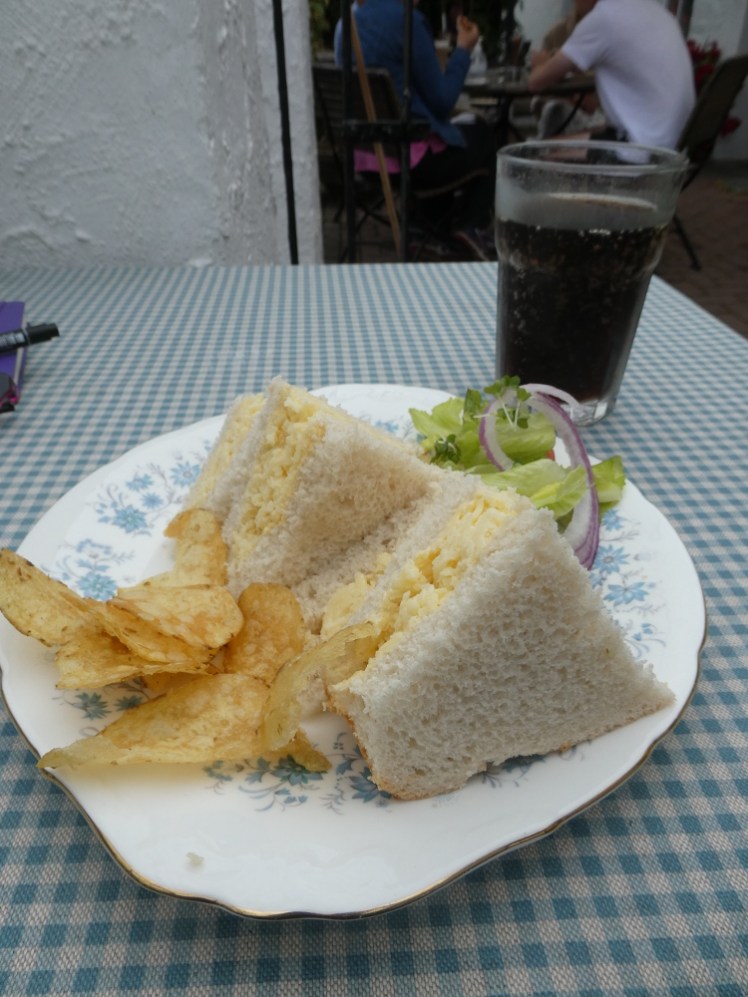
Rehydrated and fortified by food, I paid my bill, returned to my car and went off to Boscastle for the afternoon, only to find the big car park already full. Well, the afternoon was getting on by then and I’d been half-expecting it. I know what Lulworth is like in the summer and I know that the locals beg the grockles to please not park on verges, on the road or on locals’ drives and to please find somewhere else to go so I left Boscastle. The glimpse I got was nice – Brixham crossed with Cheddar Gorge – and I’ll be pleased to go back and explore that bit of coastline more thoroughly later in the year when the so-called staycationers have all gone home.
Launceston, of all places, had been enough to make Cornwall catch my interest but Tintagel has pretty much ensured I’m going to have to stay on the east side of Dartmoor from now on, otherwise I’m going to just keep leaving the moor behind and looking for pretty coastlines and villages and I’ll definitely be doing a Cornwall trip soon.